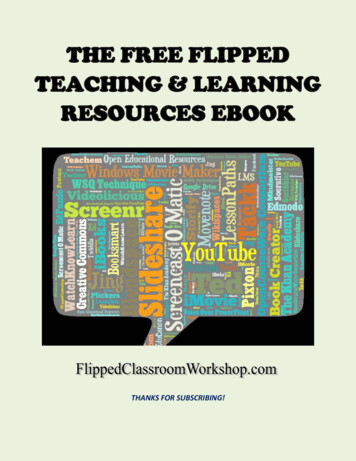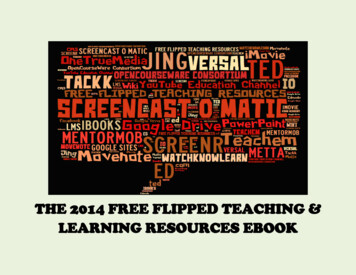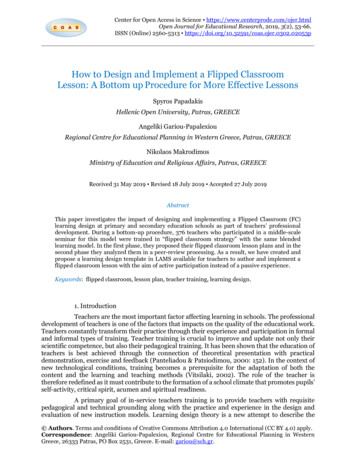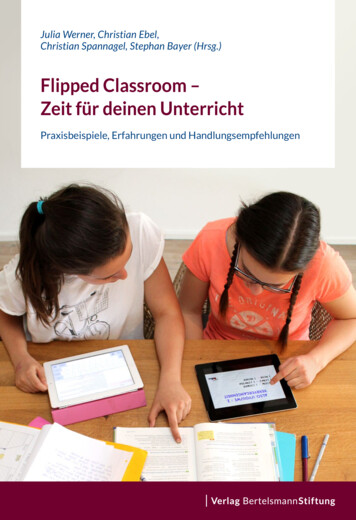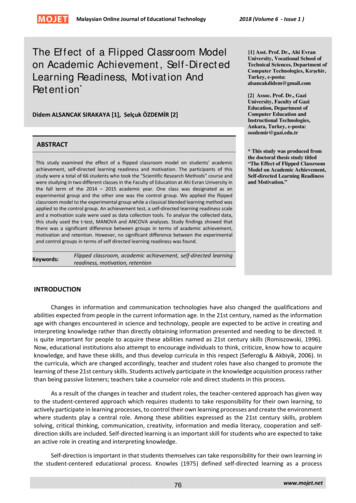
Transcription
Malaysian Online Journal of Educational TechnologyThe Effect of a Flipped Classroom Modelon Academic Achievement, Self-DirectedLearning Readiness, Motivation AndRetention*Didem ALSANCAK SIRAKAYA [1], Selçuk ÖZDEMİR [2]2018 (Volume 6 - Issue 1 )[1] Asst. Prof. Dr., Ahi EvranUniversity, Vocational School ofTechnical Sciences, Department ofComputer Technologies, Kırşehir,Turkey, e-posta:alsancakdidem@gmail.com[2] Assoc. Prof. Dr., GaziUniversity, Faculty of GaziEducation, Department ofComputer Education andInstructional Technologies,Ankara, Turkey, e-posta:sozdemir@gazi.edu.trABSTRACTThis study examined the effect of a flipped classroom model on students' academicachievement, self-directed learning readiness and motivation. The participants of thisstudy were a total of 66 students who took the "Scientific Research Methods" course andwere studying in two different classes in the Faculty of Education at Ahi Evran University inthe fall term of the 2014 – 2015 academic year. One class was designated as anexperimental group and the other one was the control group. We applied the flippedclassroom model to the experimental group while a classical blended learning method wasapplied to the control group. An achievement test, a self-directed learning readiness scaleand a motivation scale were used as data collection tools. To analyze the collected data,this study used the t-test, MANOVA and ANCOVA analyses. Study findings showed thatthere was a significant difference between groups in terms of academic achievement,motivation and retention. However, no significant difference between the experimentaland control groups in terms of self directed learning readiness was found.Keywords:* This study was produced fromthe doctoral thesis study titled“The Effect of Flipped ClassroomModel on Academic Achievement,Self-directed Learning Readinessand Motivation.”Flipped classroom, academic achievement, self-directed learningreadiness, motivation, retentionINTRODUCTIONChanges in information and communication technologies have also changed the qualifications andabilities expected from people in the current information age. In the 21st century, named as the informationage with changes encountered in science and technology, people are expected to be active in creating andinterpreting knowledge rather than directly obtaining information presented and needing to be directed. Itis quite important for people to acquire these abilities named as 21st century skills (Romiszowski, 1996).Now, educational institutions also attempt to encourage individuals to think, criticize, know how to acquireknowledge, and have these skills, and thus develop curricula in this respect (Seferoglu & Akbiyik, 2006). Inthe curricula, which are changed accordingly, teacher and student roles have also changed to promote thelearning of these 21st century skills. Students actively participate in the knowledge acquisition process ratherthan being passive listeners; teachers take a counselor role and direct students in this process.As a result of the changes in teacher and student roles, the teacher-centered approach has given wayto the student-centered approach which requires students to take responsibility for their own learning, toactively participate in learning processes, to control their own learning processes and create the environmentwhere students play a central role. Among these abilities expressed as the 21st century skills, problemsolving, critical thinking, communication, creativity, information and media literacy, cooperation and selfdirection skills are included. Self-directed learning is an important skill for students who are expected to takean active role in creating and interpreting knowledge.Self-direction is important in that students themselves can take responsibility for their own learning inthe student-centered educational process. Knowles (1975) defined self-directed learning as a process76www.mojet.net
Malaysian Online Journal of Educational Technology2018 (Volume 6 - Issue 1 )whereby students take the initiative with or without receiving support, diagnose their learning needs,formulate learning goals, determine human and material resources for learning, choose and implement anappropriate learning strategy for the knowledge to be learned, and evaluate learning outcomes. In the selfdirected learning process, individuals set their learning goals, make their own decisions to acquireknowledge, use information acquisition methods actively and fulfill and evaluate learning on their own (Salas,2010).Although different definitions for self-directed learning exist, Caffarella (2000) indicated the commonpoints of these definitions as that individuals take responsibility for their own learning, plan for the learningprocess and fulfill and evaluate their learning. In the current information age, picking the necessaryinformation out of the ever-increasing knowledge stack, formulating appropriate strategies and being ableto manage their own learning process are important for educational process effectiveness. Therefore,acquiring these skills has become a necessity. Acquiring these skills so important in the educational processcan be possible in the educational environment especially when teachers use information andcommunications technology in creating student-centered educational environments. Because of the everincreasing technological developments and the fact that students use technology and the Internetextensively in their daily lives, use of the most recent technologies in education has become inevitable.The distance learning process which started with correspondence courses has continuously changedto satisfy different needs and limitations. The flipped classroom model has become one of the latest learningmethods in recent years and it requires technology use. Although the flipped classroom (FC) model is not anew educational method, it has gained popularity with technology use in education (Jensen, Kummer, &Godoy, 2015). The FC method gives students the opportunity to learn course concepts outside the classroomenvironment with online educational materials such as video, film and voice so that classroom time is usedfor active learning such as problem solving and practical applications (Bergmann & Sams, 2012). This method,whereby students learn the theoretical part of the course at home before class, allocates classroom time foractive learning practices such as question-answer, discussion and problem solving. In the FC model, studentstake responsibility for their own learning and progress at their own speed (Davies, Dean, & Ball, 2013).Students fulfill independent and active learning by accessing the learning environments presented throughthe Internet whenever and wherever they want (Baker, 2000). The assessment of this model in terms ofBloom's taxonomy steps showed that students fulfill learning with regard to knowledge and comprehensionby watching videos before class and they fulfill learning with regard to application, analysis, synthesis andevaluation by participating in classroom activities (Rutkowski & Moscinska, 2013). With the characteristics ofthe flipped classroom model where the learning environments provide a personal learning experience(Hamdan, McKnight, McKnight, & Arfstrom, 2013), teachers take a counselor role and students are activeparticipants (Halili & Zainuddin, 2015; King, 1993), students take on the learning responsibility and progressat their own speed (Davies et al., 2013).Self-direction skills are quite important for online learning media where students have more control,independence and responsibility in personal learning processes in comparison with face-to-face learningenvironments (Kocdar, 2015). Online learning has an effect on self-direction (Song & Hill, 2007); studies haveshown that a relationship exists between self-directed learning and achievement. Students having higherlevels of self-directed learning skills also have higher levels of achievement with knowledge acquisition andmanagement (Merriam & Caffarella, 1991). Similarly, Salas (2010) reported that online courses in highereducation and distance learning programs are considered among important steps that support self-learning.The flipped learning which requires students to take more control over their learning with its dimension thatis fulfilled on the Internet (Gunawardena & McIssac, 2003) can ensure that students engage in self-directedlearning more effectively by providing them independence and flexibility (Sahin, 2010).On the other hand, the flipped classroom model requires students to manage and maintain motivationfor both implementing self-directed learning and enabling students to manage their own learning processes.Student motivation is an important prerequisite for managing their learning process (Boevé et all., 2016).Song and Hill (2007) defined one of the three main characteristics of self-directed students as motivation.Motivation is the reason people make an effort (Kurt, 2005), and self-directed students should make an77www.mojet.net
Malaysian Online Journal of Educational Technology2018 (Volume 6 - Issue 1 )effort for their learning process. Therefore, motivation is a prerequisite for self-directed learning. Studentshaving higher motivation also have higher levels of self-directed learning skills (Candy, 1991). Hence, in thelearning environment, motivation is a dimension that should be taken into consideration (Dede & Argun,2004). Learning environments that set students in motion, in which students have adequate capabilities,reveal their own values and can experience achievement and failure, can affect motivation (Unsal, 2012). Inrecent years, it has been reported that student motivation is an important factor in terms of increasingachievement in educational environments which have been differentiated with technological developments(Deveci-Topal, 2013). Studies have concluded that web-based learning, online learning, and blended learningenvironments, which became part of the educational process along with technology, influence studentmotivation (Acar, 2009; Deveci-Topal, 2013; Unsal, 2012).This study aimed at examining the effect of the flipped classroom model on individuals' self-directedlearning skills and motivation. It was thought that the flipped classroom model may have an effect on selfdirected learning and motivation in the light of its characteristics as mentioned before. Therefore, this studyaimed at examining the effect of the flipped classroom model on self-directed learning readiness,achievement and motivation. While the flipped classroom model is compared with the traditional learningenvironment in existing studies, this study compared FC with the classical blended learning method. For thisreason, it is thought to contribute to the literature. These are the research questions to be answered in linewith this purpose:1. Is there a significant difference between the experimental and control groups in terms of academicachievement scores?2. Is there a significant difference between the experimental and control groups in terms of self-directedlearning readiness levels?3. Is there a significant difference between the experimental and control groups in terms of motivationlevels?4. Is there a significant difference between the experimental and control groups in terms of retentionscores?METHODResearch Design: This was a quasi-experimental pre-test–post-test study with a control group. This designunbiasedly assigns groups not to be changed as an experimental and a control group. Groups were measuredusing a pre-test before the study and measured twice using a post-test after the study (Buyukozturk, KilicCakmak, Akgun, Karadeniz, & Demirel, 2008).The Sample: The sample of this study included a total of 66 students, in two branches with 32 and 34individuals, respectively, in each class, who took the "Scientific Research Methods" course in the Departmentof Psychological Counseling and Guidance, Faculty of Education at Ahi Evran University in the spring term ofthe 2014 – 2015 academic year. Existing groups were assigned randomly as an experimental and a controlgroup.Data Collection Tools: Within the scope of this study, motivation and learning strategies scales, a selfdirected learning readiness scale and an academic achievement test were used as data collection tools.General Academic Achievement: To determine student academic achievement in the "Scientific ResearchMethods" course, this study used an achievement test, weekly quizzes and activities for higher-orderlearning. The total academic achievement score was calculated as 40% from the achievement test, 20% fromweekly quizzes and 40% from the higher-order learning activities.Achievement test: This study used the achievement test developed by the researcher. The validity andreliability analyses of this test were also performed by the researcher. The achievement test was created in78www.mojet.net
Malaysian Online Journal of Educational Technology2018 (Volume 6 - Issue 1 )accordance with the table of specifications prepared in the light of acquisitions specified for the course.Firstly, expert opinions on the achievement test were noted and necessary changes were made according tothe opinions. Some items have been revised or removed. After the implemented changes, test item analysiswas performed. The item analysis of this achievement test was performed with 252 students from theDepartments of Primary School Teaching, Science Teaching and Turkish Language Teaching at Ahi EvranUniversity and Niğde University; they had taken the "Scientific Research Methods" course and were not partof the actual study. After the item analysis, the items with a discrimination less than 0.30 (16 items) wereremoved from the test and a final test consisting of 40 questions was made. The Kuder-Richardson-20 (KR20) reliability coefficient of the final form of the 40-item multiple choice achievement test was found to be0.80.Weekly quizzes: Weekly quizzes were developed to test for subject content. These quizzes included multiplechoice questions. Firstly, expert opinions on the prepared items were noted. As a result of the pre-applicationmade after necessary changes were implemented, item analysis was performed, and the items with adiscriminatory power below 0.30 were excluded from the quizzes. The remaining questions were used asweekly quizzes on the subject of the week. After item analysis, a total of 30 questions remained to be usedin the weekly quizzes. Moreover, some questions of the achievement test, which was developed by Olpak(2013) for the “Scientific Research Methods” course, and of which the KR-20 reliability coefficient was 0.90,were used in the weekly quizzes.Activities for higher-order learning: The researcher developed activities at the levels of analysis, evaluationand creation according to Bloom’s taxonomy. For the activities, opinions from six experts were collected andnecessary changes were made. All group members achieved the same scores on group work activities.Activities were assessed out of 100 in the light of the specified answer key. In the application process, theresearcher and the subject matter expert separately scored the first two activities, and it was shown thatthere was a high-level positive correlation between the respective scores (r1 .91, p 0.00 0.01 and r2 .96, p 0.00 0.01). To provide feedback on activities to students during course hours, the researcher, whowas also the course teacher, did the scoring for the other activities.Self-directed Learning Readiness Scale (SDLRS): To determine students' self-directed learning readinesslevels, this study used the Self-directed Learning Readiness Scale (SDLRS) developed by Fisher et al. (2001)and adapted in Turkish by Sahin and Erden (2009). This scale included three sub-factors: self-direction,willingness to learn and self-control abilities. This is a 5-point Likert-type grading scale which was structuredas strongly disagree (1), disagree (2), partially agree (3), agree (4), and strongly agree (5). This study foundthe Cronbach’s alpha coefficient to be .93 for the entire scale, .87 for the self-direction subdimension, .86 forthe willingness to learn subdimension, and .79 for the self-control abilities subdimension.Motivation and Learning Strategies Scale (MLSS): The MLSS scale developed by Pintrich, Smith, Garcia, andMcKeachie (1991) was adapted into Turkish by Buyukozturk, Akgun, Ozkahveci, and Demirel (2004). This scaleconsists of two main parts: a “motivation scale” comprising 6 factors and a “learning strategies scale”comprising 9 factors. This is a 7-point Likert-type grading scale varying between “Definitely wrong for me”(1) and “Definitely right for me” (7). To determine student' motivation levels within the scope of this study,intrinsic goal orientation (4-item), extrinsic goal orientation (4-item), task value (5-item), control of learningbeliefs (4-item), self-efficacy for learning and performance (4-item), and test anxiety (5-item) factors of the“motivation scale” dimension of the scale were examined.Learning Environment: The online learning environment used in this study was created taking thecharacteristics of the target group and design principles into consideration. This study had consulted fourexperts in the Computer and Instructional Technologies Teaching field about the developed learningenvironment and necessary changes were made. Moreover, the field experts had also examined the content,and in the light of criticisms, it was revised.To test the learning environment performance, this study administered a pre-application test on agroup consisting of 10 third year students from the Department of Computer and Instructional TechnologiesTeaching, Faculty of Education at Ahi Evran University. In the pre-application process, this study ensured that79www.mojet.net
Malaysian Online Journal of Educational Technology2018 (Volume 6 - Issue 1 )students logged into the site simultaneously and determined the current technical problems by accessing thecontent, watching videos, answering questions, discussing among themselves on forums and sending privatemessages. Therefore, the problems encountered by users in the application process were eliminated beforethe process began. After the test, semi-structured interviews were administered to the students; they hadpositive opinions on the system, showing that the problems had been solved. We then began theexperimental method after the web environment was appropriate and ready.Students in both groups logged into the learning environment with their user names and passwords.They logged into the system using the same screen; however, they were directed to different pages andcontent according to their groups. The learning environment included a home page, teaching plan, forum,announcement and contact pages. It was possible to access menus and the content from the home page. Thecurriculum and weekly schedules were presented on the teaching plan page. Students directed theirquestions to the course teacher and other students using the forum page. They could create a new questionand respond to or display the existing questions. Course teachers could share their announcements on theannouncement page. Furthermore, there was a Submit Assignments menu for the control group, andstudents could submit their weekly homework using this menu.Experimental Procedure: In the application process, this study administered the flipped classroom model toone group and a classical blended learning method to the other one. Students in both groups used thelearning environment developed by the researcher as a system. Both groups receive lectures from the sameteacher. Only registered users could access the online content. Students in the experimental group learnedthe theoretical part of the course at home before class by watching content-oriented videos and then takingweekly quizzes at the end of the videos within the scope of the flipped classroom model. Thus, in course timespent in the classroom, they participated in active learning activities in the form of question-answer anddiscussion. These students also did higher-order learning-oriented activities, which were developed by theresearcher, in the classroom environment. However, within the scope of the classical blended learningmethod, students in the control group learned the theoretical part of the course in the classroom and thenthey answered the same questions that the other group responded to at the end of the videos in the onlineclassroom environment. They did higher-order learning-oriented activities as homework and submitted itthrough the system. The experimental group learned lessons at home and did homework in school while thecontrol group did just the opposite. In out-of-school time, students in both groups could ask their questionsto the course teacher and other students via the forum.Data Analysis: In the data analysis period, this study performed an independent sample t-test, MANOVAanalysis and ANCOVA analysis to examine the effect of the implemented educational method on academicachievement and self-directed learning readiness, on motivation, and on retention, respectively.RESULTS AND DISCUSSIONBefore the analyses, it was checked whether the parametric test assumptions were met. For t-test,normality and homogeneity of variance assumptions were tested. For MANOVA, sample size, normality,linearity, homogeneity of variance-convergence matrix and multicollinearity (Field, 2009) assumptions werechecked. According to these results t-test, Mann Whitney U and MANOVA test were used in the data analysis.Pretest AnalysesBefore the data analysis, to examine whether the experimental and control groups were equal, thegroups were compared in terms of academic achievement, self-directed learning readiness and motivation.This study used an independent sample t-test to compare academic achievement and motivation of thegroups and performed a Mann Whitney U analysis to compare self-directed learning readiness. MannWhitney U test was used to compare the self-directed learning readiness pre-test averages of the groups,because self-directed learning readiness pre-test scores were not normally distributed. The analysis resultsare illustrated in Table 1.80www.mojet.net
Malaysian Online Journal of Educational Technology2018 (Volume 6 - Issue 1 )Table 1. Independent Sample t-test results for pre-test Scores of the Experimental and Control Group onAcademic Achievement, Motivation and Self-directed Learning mentalGroupControl GroupGroupsExperimentalGroupControl 41.70.09SDtp640.30.72Experimental Group: The group that experienced the flipped classroom modelControl Group: The group that underwent the classical blended learning methodTable 2. Mann Whitney U analysis results for pre-test Scores of the Experimental and Control Group onSelf-directed Learning ReadinessSelf-directedLearningReadinessGroupsNMean RankSum ofRanksExperimentalGroup3231.561010Control Group3434.391135MannWhitney Uzp482-0.6040.55Experimental Group: The group that experienced the flipped classroom modelControl Group: The group that underwent the classical blended learning methodThis study found no significant difference between mean scores of the groups in terms of achievement[t(64) 1.7, p 0.05], motivation [t(64) -0.3, p 0.05], and self-directed learning readiness [z -0.604, p 0.05]. According to these findings, it can be concluded that both the experimental and control groups wereequal in terms of achievement, motivation and self-directed learning levels.The effect of the implemented educational method on general academic achievementThis study performed an independent sample t-test to analyze the difference between generalacademic achievement scores which were calculated using weekly quiz scores, higher-order learningactivities scores and achievement test scores of the students in both the experimental and control groups.The findings of the mean scores of groups are shown in Table 3.Table 3. Independent Sample t-test results for academic achievement scores of the experimental andcontrol alGroup3279.417.35Control Group3472.049.63SDtpη2643.470.000.159Experimental Group: The group that experienced the flipped classroom modelControl Group: The group that underwent the classical blended learning method81www.mojet.net
Malaysian Online Journal of Educational Technology2018 (Volume 6 - Issue 1 )Table 3 showed that there was a significant difference between post-test mean scores of theexperimental and control groups on general academic achievement [t (64) 3.47, p 0.05]. This findingindicated that the flipped classroom model has the effect of increasing students' achievement. As a result ofthe analysis, this study found the effect size to be η2 0.159. This value indicated a high-level of effect power.In terms of academic achievement, scores of the students who used the flipped classroom model werehigher than scores of those who used the classical blended learning method. This result showed that studentsusing the FC model were more successful. This can be the result of the fact that because students learn thetheoretical part before the class in the FC model, they can ask their questions in the classroom, receiveimmediate feedback and also interact with the course teacher during the lesson. The characteristics of theflipped classroom model such as students can come to class prepared in advance (Halili & Zainuddin, 2015;Zappe, Leicht, Messner, Litzinger, & Lee, 2009), increased student-teacher interaction (Arshad & Imran,2013; Bergmann, Overmyer, & Wilie, 2013; Bergmann & Sams, 2012; Halili & Zainuddin, 2015; Kim, Patrick,Srivastava, & Fellow, 2014; Rutkowski & Moscinska, 2013) and students have opportunity to receiveimmediate feedback (Arshad & Imran, 2013; McGivney-Burelle & Xue, 2013; McLaughlin et al., 2014; Milman,2012) explained the students’ achievement increase. Baepler, Walker, and Driessen (2014) reported thatinteracting with the course teacher, asking questions and receiving answers have a positive effect on studentachievement. Furthermore, this study also found that student motivation in the experimental group washigher than that in the control group. It is likely that the higher motivation level caused higher achievementin the experimental group.Motivation is an important factor in increasing achievement (Deveci-Topal, 2013). Kettle (2013) foundthat students with higher motivation had higher achievement levels. The findings of studies in the literaturethat the flipped classroom model has increased student achievement (Boyraz, 2014; Chao, Chen, & Chuang,2015; Cook, 2013; Day & Foley, 2006; Hung, 2015; Kim, Patrick, Srivastava, & Fellow, 2014; Lemley et al.,2013; Love Hodge, Grandgenett, & Swift, 2014; Mason, Shuman, & Cook, 2013; Pierce & Fox, 2012; Street,Gilliland, McNeil, & Royal, 2015; Tune, Sturek, & Basile, 2013; Turan, 2015; Wiginton, 2013) are aligned withthe findings of this study. Although many studies in the literature have supported the findings of this study,some studies found that the flipped classroom model has no positive effect on achievement (Davies et al.,2013; Findlay-Thompson & Mombourquette, 2014; McLaughlin et al., 2013; Overmyer, 2014). In other words,results have differed in studies examining the effect of the flipped classroom model on student achievement.This difference can be attributed to the different processes, materials and environments used in applying theFC model. The effect of this model on student achievement showed a difference because different materialswere used during different lessons. The types of materials used and the surrounding learning environmentcan affect achievement. Moreover, educationists managing the process plan it in different ways and dodifferent classroom activities. These differences in activities probably generated different results.The effect of the implemented educational method on self-directed learning readinessTo analyze whether there was a significant difference between self-directed learning readiness subfactors and total scores of students in the FC group and students in the classical blended learning group, thisstudy performed an independent sample t-test. The findings of the self-directed learning scores of the groupsare shown in the following Table 4.82www.mojet.net
Malaysian Online Journal of Educational Technology2018 (Volume 6 - Issue 1 )Table 4. Independent Sample t-test results for self-directed learning readiness and post-test scores of theexperimental and control groupsScoresSelf-directionWillingness eadinessGroupsNSExperimental Group324.210.32Control Group3440.73Experimental GroupControl GroupExperimental GroupControl ntal Group324.050.30Control 40.640.52Experimental Group: The flipped classroom groupControl Group: The classical blended learning method groupTable 4 showed that no significant difference existed between both self-direction [t(64) 1.55, p 0.05], willingness to learn [t (64) 0.75, p 0.05] and self-control abilities [t (64) 0.36, p 0.05] subdimensionsof self-directed learning readiness total scores [t (64) 0.64, p 0.05] according to the study environment ofstudents. In other words, students' scores on self-directed learning readiness and sub-factor scores did notchange according to the learning environment.This study found no difference between self-directed learning readiness levels of students under theflipped classroom model and those using the classical blended learning method. Although it was reported inthe literature that the FC learning environment can have a positive effect on s
directed learning and motivation in the light of its characteristics as mentioned before. Therefore, this study aimed at examining the effect of the flipped classroom model on self-directed learning readiness, achievement and motivation. While the flipped classroom model is compared with the traditional learning
